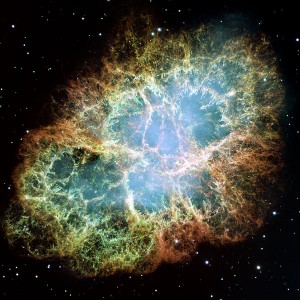
A high mass star has more matter than a low mass star. More matter increases a star’s gravitational field. Gravity produces the heat that initiates fusion. Fusion occurs more readily in a high mass star. It also lowers life expectancy. It can result in a supernova event and the producing of a neutron star. Some say it can even result in a black hole.
Fusion
Fusion begins by combining hydrogen atoms into helium atoms. As hydrogen diminishes, it is predominantly helium atoms that fuse. Helium concentrates at the center since gravity pulls it more due to its greater mass. As the helium fuses, it forms carbon atoms. Carbon then gravitates to the center of the star.
Over time, layers form. The last element formed at the end of the life of a high mass star is iron. A cross section of the star reveals onion like layering. Iron is at the center. Then comes silicon. After that, layers include magnesium, neon, oxygen, carbon, helium and the last of the hydrogen.
Variety of Fusion
Stars larger than about 1.3x the mass of the Sun undergo CNO cycle fusion. C stands for carbon, N for nitrogen, and O for oxygen. This differs from the fusion of lower mass stars. That is called the proton-proton process.
In the CNO cycle, carbon acts as catalyst. A catalyst is a substance involved in reaction, but not lastingly consumed. During the fusion of hydrogen into helium, the catalyst is re-released. It continues the process with additional hydrogen atoms.
High Mass Star As Fusion Subsides
As fusion subsides, outward pressure within the star decreases. Gravity pulls the star inward. This divides the star into two parts. The heavy materials such as iron form first a white dwarf. Then because the gravity is so great it forces the electrons to merge with the protons, to form a neutron star. The outer shell explodes outward. This is a supernova event. If the mass is yet greater, a black hole may result.
Supernova Shell
The violence of the supernova erupts brilliantly. It produces a shock wave that converts some of its material into elements heavier than iron. These include zinc, silver, tin, gold, mercury, lead and even uranium. These elements are scarce in space because they take energy to produce by fusion. A famous historical supernova is that of the Crab Nebula, observed by Chinese astronomers in the year 1054 AD.
Note: You might also enjoy Three Hydrogen Isotopes: Protium, Deuterium, Tritium
References:
- The University of Tennessee – Knoxville: The CNO Cycle
- New Mexico State University: The Lives of High Mass Stars
- Arstechnica: Interstellar gas allows chemical reactions caused by quantum tunneling
← Back to Classic-Science
← Home
